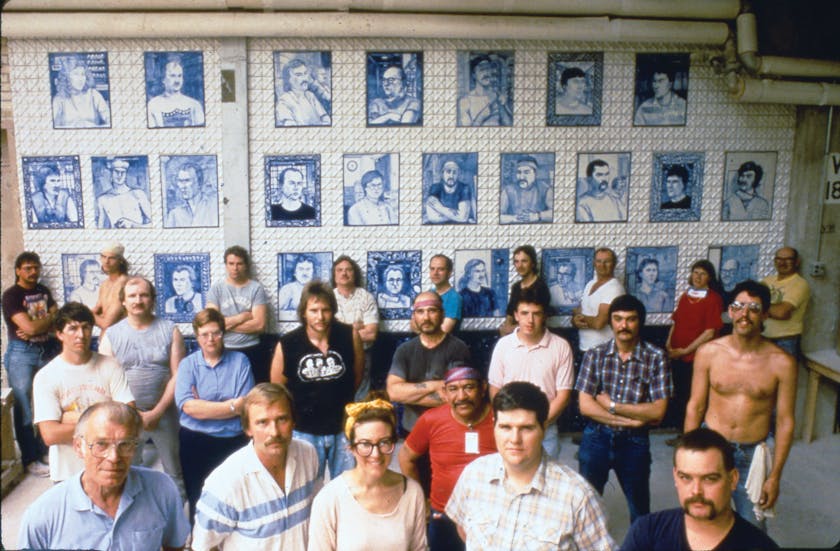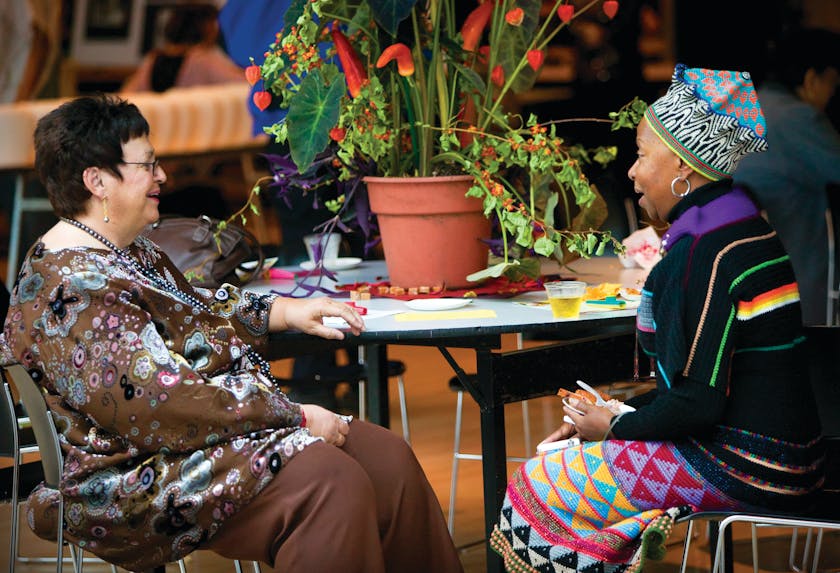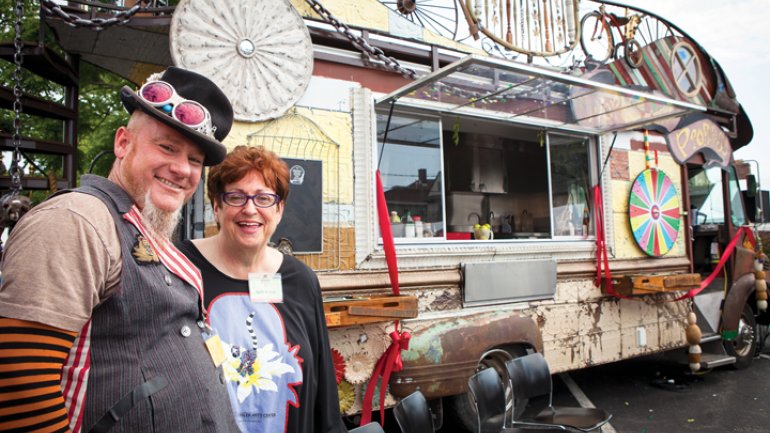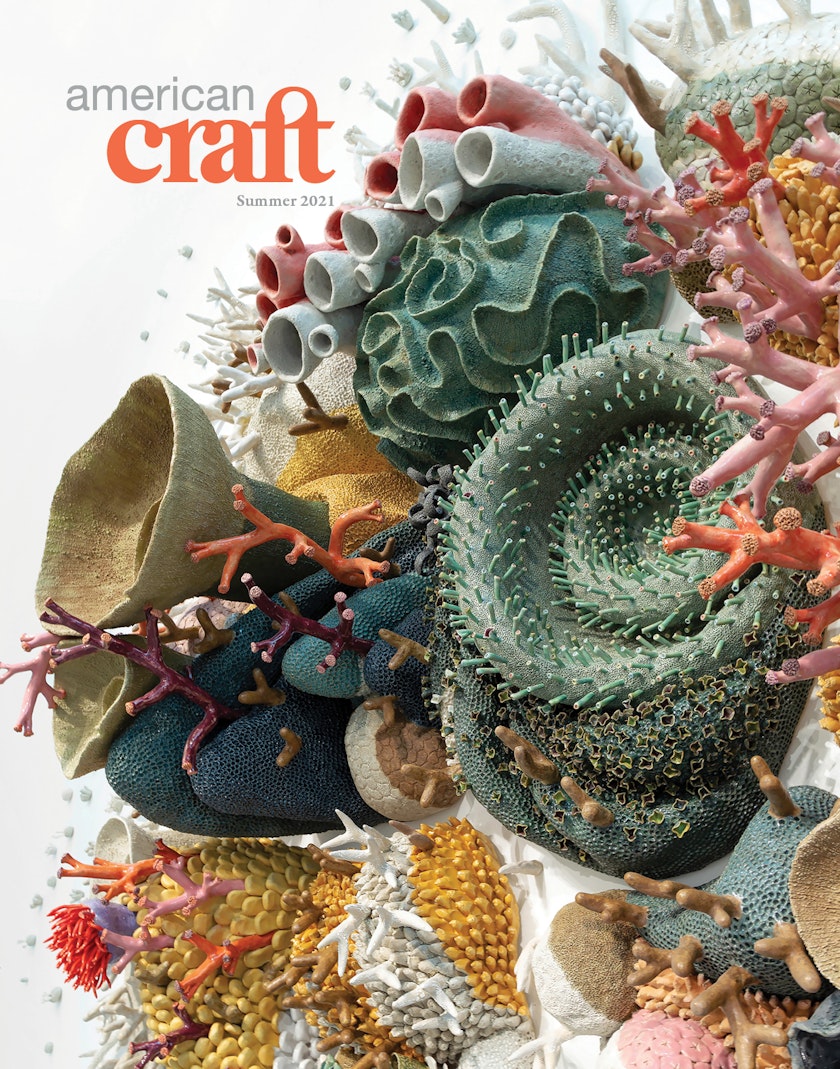The Advocate
The Advocate
Ruth DeYoung Kohler II (right) loved artists. She’s pictured here in 2014 with the artist Mac Maker in front of the Culinary Art Car he created with Sheboygan community members as part of Kohler’s Connecting Communities program. Photo courtesy of the John Michael Kohler Arts Center.
There’s also no residency program in the world quite like Arts/Industry, and that’s largely thanks to the indelible impact of Ruth DeYoung Kohler II, who was instrumental in establishing the program and shepherding it through its first four decades. When she died last November at age 79, the opening of the latest addition to the constellation of JMKAC programs—an innovative new building for the Art Preserve—had been postponed due to the COVID-19 pandemic. When it opens this June, this new exhibition space devoted to artist-built environments will be a fitting coda to Kohler’s lifelong devotion to cultivating and caring for the places and materials from which artists create new works.

Tom LaDousa and Jack Earl, the first Arts/Industry residents, with Kohler Co. experimental caster Clayton Hill in 1974. Photo courtesy of the John Michael Kohler Arts Center’s Arts/Industry Artist Archives.
One word in particular emerges over and over in pieces of writing about Ruth Kohler’s life: vernacular. A 1992 Honorary Fellow of the American Craft Council, she was fascinated by the work of self-taught artists, and by the quirky, DIY innovations they devised to create their own homes and studios. A granddaughter of the Kohler Company’s founder, John Michael Kohler, Ruth spent many weekends of her childhood enjoying drives with her family around Sheboygan and its rural outskirts. Ruth was intrigued by the curious, homespun installations they would find dotting the landscape during these excursions, particularly the “bathtub shrines.” Local farmers would upend a Kohler fixture and half bury it so the top part created an arched niche and then place a statue of a religious figure inside. Here, Ruth was witnessing members of the wider Sheboygan community adapting the castoffs of Kohler’s industrial output as though they were shells washing up on the shoreline.
As a young woman, Ruth earned a BA in history and art at Smith College and undertook additional studies at the University of Wisconsin and the University of Hamburg. She taught art in a public school in Beloit, Wisconsin, then taught at the University of Alberta–Calgary and established a new printmaking program there. She even spent a year in Spain as an artist while studying Paleolithic cave paintings and vernacular art. But her widowed father’s declining health drew her back to Sheboygan, and it made perfect sense for her to establish a professional connection to the John Michael Kohler Arts Center. The organization had been established in 1959 by the Sheboygan Arts Foundation and was named in honor of her grandfather.
Ruth started out as a volunteer, eventually taking on the position of assistant director from 1968 to 1972, then serving as director until her retirement in 2016. Her devotion to vernacular art forms and artist-built environments is an essential element of her legacy at JMKAC, but it’s the Arts/Industry program—which she helped spearhead in the early 1970s—that most clearly demonstrates the organization’s unique ability to support and inspire artists at work.
Ruth Kohler was driven to seek artistic magic in unexpected places, and two such places were the factory production floors in the Pottery and Foundry departments of her family’s eponymous plumbing manufacturing company. Faythe Levine, director of the Arts/Industry program, points to the pivotal 1973 exhibition The Plastic Earth as a turning point in the story of Arts/Industry at JMKAC. This exhibition brought together contemporary ceramics from the United States and Canada at the Arts Center, and the Kohler Company was a sponsor of the show. Many of the artists came to Sheboygan for the opening reception, and Ruth had the idea to bring them to the factory so they could see all the materials, tools, and processes up close.

Kohler Co. associates standing in front of their portraits by Arts/Industry artist in-residence Ann Agee (front row, center) at Kohler Co. Pottery in 1991. Photo courtesy of the John Michael Kohler Arts Center’s Arts/Industry Artist Archives.
“That’s when they opened up the Pottery to have artists listen to the technicians talk about their process and do demos,” Levine says. “Some of the artists gave Ruth some feedback—We’d love to come work here!—and a fire was ignited. In 1974, the pilot version of the first Arts/Industry residency was launched.” Artists Jack Earl and Tom LaDousa were the inaugural residents.
In a feature article for Milwaukee Magazine published shortly before Ruth’s death last year, writer Mary Louise Schumacher cites an essay from the book Arts/Industry: Collaboration and Revelation, which was published in celebration of the residency’s 40th anniversary. Ruth and co-authors Susan Barnett and Emily Schlemowitz wrote in their essay “A Mad Dash at Something” that some of the factory technicians had assumed the artists would be “strange, lazy dilettantes”—that is, until they witnessed the artists’ work ethic firsthand. Both camps, the technicians and the artists, quickly realized something unique and exciting was afoot.
“Ruth had already contributed to the art world as a visionary curator, but also coming from this manufacturing family she realized there was a bridge to be built between the two, and figured out how to bring the artists into the manufacturing process, giving them space, materials, and instruction in the processes,” says Levine. “From that point forward, she brought artists into the factory, and also brought the work they were making into an exhibition space at the Arts Center. So not only are you offering artists materials, space, and support, you’re also offering them an exhibition opportunity.”
This is what made Ruth and her endeavors unique, says Amy Horst, associate director of JMKAC. Horst says she’s been asked over the years by other arts professionals how they might create programs like those at JMKAC, but often what’s missing is a patron like Ruth. “I’m not sure if someone else could do it,” she says of building a program like Arts/Industry. “Ruth was able to translate the language of the [Kohler] company and the artists. She could understand and explain what an artist might need and articulate that to the company, and in turn she could represent the company’s needs and what they value. She was uniquely positioned to do that ‘translation’ work.”

Arts/Industry artist-in-residence Risa Puno in the Kohler Co. Foundry in 2018. Photo courtesy of the John Michael Kohler Arts Center.
Still, there are aspects of Ruth’s approach that could probably be adapted to other organizations. Artist Beth Lipman, an alumna of the Arts/Industry program (2003 and 2015) who was also its coordinator from 2005 to 2009, points to Ruth’s ability to give all kinds of art and artmaking a home. (Lipman is currently at work on Wild Madder, an artist-made washroom for the new Art Preserve building.) “The John Michael Kohler Arts Center was decades ahead of its time in contextualizing all forms of art: conceptual, craft-based, nonacademic, and performative, all within thematic exhibitions that provoked the viewer to reevaluate their belief systems.”
This meant that a wide array of audiences can find something that speaks to them at JMKAC, says Lipman. “The programming remains impactful to all audiences, whether they are entrenched in the field or a casual visitor. Ruth’s impact cannot be overstated; she created a platform for artists who are under-recognized, marginalized, emerging, and established to grow their practice and exhibit their work.”
Artist Giselle Hicks, an Arts/Industry resident in 2005 and 2012, explains that part of the magic of being there is that it provides a bracing, totally different kind of structure and community to the artists who take part in the program. “Artists tend to live by their own rules and whims, are adept at improvisation, and have subjective expectations regarding the outcome of their work. The engineers, designers, and fabricators at Kohler possess a deep knowledge of their material and approach their jobs with clear, objective expectations regarding the outcome of their work,” Hicks explains. This presents artists with a stark challenge: they need to know exactly what they want to do, because they need to explain it to a very knowledgeable person in precise, practical terms, which isn’t necessarily something that would happen in an MFA program with professors and fellow artists, at a studio-based residency, or even in conversation with a curator.
“Ruth put those two kinds of people in the same room together and encouraged dialogue and collaboration,” Hicks adds. “The two approaches to making might have been unrelated, but the common ground was a shared interest in the material. That made for a fascinating place to start a conversation, which only helped to cultivate a deeper appreciation for this complex material. The relationships that evolved between the Kohler associates and artists, linked by material and the factory limitations, benefited both. For me, what I learned and experienced at Kohler became foundational for my future work.”
“Ruth’s impact cannot be overstated; she created a platform for artists who are under-recognized, marginalized, emerging, and established to grow their practice and exhibit their work.” —Beth Lipman
The challenge facing JMKAC now that Ruth’s gone is to maintain the best parts of her leadership in her absence. The program will never have another Ruth Kohler, but because her work was driven by a desire to connect people across different fields, interests, communities, and even skills, her legacy has teed up a continuing dialogue and fruitful partnership between the Arts Center and the Kohler Company. The team at JMKAC has taken some practical steps to make this happen: Faythe Levine created an Arts/Industry handbook and developed an official orientation process for new residents, to set parameters for some of the introductory rituals that had previously been informal.
Amy Horst adds that the Kohler Company offers artists exposure beyond their time at the factory: the entire front section of the Kohler Experience Center in New York City near the Flatiron Building is devoted to an Arts/Industry display where works from the company’s permanent collection rotate throughout the year. As a result, architects, interior designers, and passersby in the neighborhood who see something remarkable in the window can get a glimpse of what’s happening in Sheboygan—a dynamic that echoes the ideal that inspired Ruth’s lifelong work as a creative connector. “People from all walks of life can see each other, in the context of the factory floor, and find different ways of achieving mutual respect,” Horst says. “For Ruth, it was about building relationships.”

Ruth Kohler chats with artist Xenobia Bailey during a celebration of the John Michael Kohler Arts Center’s American Story series in 2009. Photo courtesy of the John Michael Kohler Arts Center.
Kohler’s Senior Vice President Laura Kohler is justifiably proud of her aunt’s legacy. “She worked tirelessly to champion under-recognized artists and art forms, and believed strongly that art drives positive social change,” says Laura. “Without Ruth’s vision and curatorial guidance, the Arts Center and Kohler Foundation would not have been able to save significant works of art for the public to appreciate and experience. The new Art Preserve is a culmination of her life’s work, passions, and dedication. It will only deepen and extend her legacy, serving as an amazing gallery that celebrates art-environment builders and houses an expanding collection of preserved works.”
Ruth left a more personal mark, too. “Ruth Kohler brought joy and warmth to anyone who had the good fortune to come in contact with her,” says Laura, “and she will be so deeply missed.”
Learn About Other Leaders in the Craft World Through Our Magazine
Become a member to get a subscription to American Craft and read about the inspiring people who are moving our field forward.





